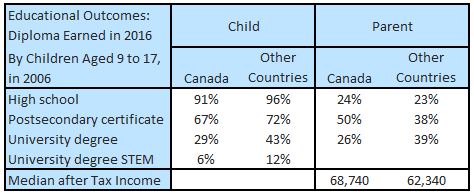The Economics and Statistics Division maintains archives of previous publications for accountability purposes, but makes no updates to keep these documents current with the latest data revisions from Statistics Canada. As a result, information in older documents may not be accurate. Please exercise caution when referring to older documents. For the latest information and historical data, please contact the individual listed to the right.
<--- Return to Archive
For additional information relating to this article, please contact:
November 18, 2019STUDY: EDUCATION/ LABOUR OUTCOMES OF CHILDREN WITH IMMIGRANT BACKGROUND Statistics Canada released a study today regarding the educational and labour outcomes of children of immigrant families. Some of their findings are reported below.
Education Criteria For Economic Immigrants
Canada's immigration policies promote economic growth and prosperity. International immiration helps fill the gap in current and future labour shortages. Immigrant selection, in part, illustrates the importance of the education and vocational skills of immigration candidates. Between 2011 and 2016, among economic immigrants aged 25 to 34, 57% had university level education compared to 30% of non-immigrants. The children of highly education immigrants will extend their parents' reach to satisfy future labour requirements.
Education Outcomes of Children of Immigrant Parents

Studies have shown that a parents’ education has a greater influence than family income on education outcomes. It is the expectations and behaviours of parents that explains the education outcomes of their children, not the extent of their financial resources. Given equal family income, it is the children whose parents are more highly educated that are more likely to earn a university degree. Parents with a higher level of education are more likely than others to participate in different activities related to positive education outcomes and associated with the “cultural capital” passed on by the family: reading and communicating with the children, participating in cultural activities, buying books for the household, encouraging new knowledge learning, etc. This cultural capital is a determining factor in the educational achievement of children as soon as they start school.
Young Persons
In Canada 2016, cohort children of Canadian origin, who were aged 9 to 13 in 2006, 91% had at least completed high school. Among teens who were aged 13-17 in 2006, 67% had obtained a postsecondary certificate or degree, and 29% had a university degree (bachelor level or higher), Also, 6% of Canadian origin teens who were aged 13-17 in 2006 had a university degree (bachelor or higher) in Science, Techology. Engineering or Mathematics (STEM).
In comparison, in Canada 2016, cohort children of non-Canadian origin, who were aged 9 to 13 in 2006, 96% had at a high school. Among teens who were aged 13-17 in 2006, 72% had obtained a postsecondary certificate or degree, and 43% had a university degree (bachelor level or higher). Also, 12% of non-Canadian origin, had a university degree (bachelor or higher) in Science, Techology., Engineering or Mathematics (STEM).
Parents
In Canada 2016, parents of cohort children of Canadian origin, who were aged 9 to 17 in 2006, 24% had at a high school diploma or less, 50% had obtained a postsecondary certificate or degree, and 26% had a university degree (bachelor level or higher). Median after-tax economic family income was $68,740.
In comparison, parents of cohort children of non-Canadian origin, who were aged 9 to 17 in 2006, 23% had a high school diploma or less, 38% had obtained a postsecondary certificate or degree, and 39% had a university degree (bachelor level or higher). Median after-tax economic family income was $62,340.
While median income of immigrant parents (non-Canadian origin) is lower and their education levels are higher than the median income and education level of third generation parents (Canadian origin), the education outcomes of their children are higher.
Gender and Educational Outcomes
In Canada 2016, young men of Canadian origin, who were aged 13-17 in 2006, 21% had a university degree (bachelor level or higher), whereas young women of Canadian origin, 36% had a university degree (bachelor level or higher), a 1.71 ratio in favour of young women.
Source: Statistics Canada,
The study "Educational and labour market outcomes of children with an immigrant background by their region of origin", Ethnicity, Languages and Immigration Thematic Series (Catalogue number 89-657-X)
Summary version, "Results from the 2016 Census: Education and labour market successes and challenges for children of immigrant parents," Insights on Canadian Society (Catalogue number 75-006-X)
<--- Return to Archive